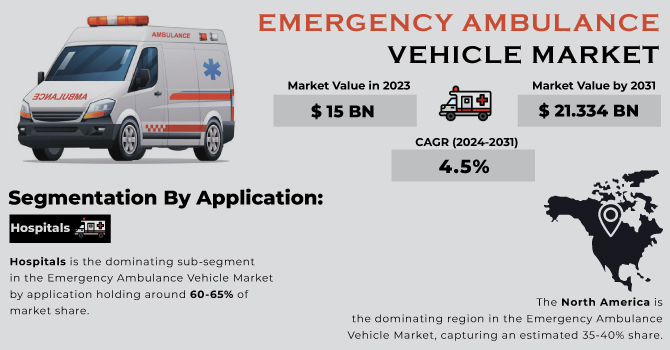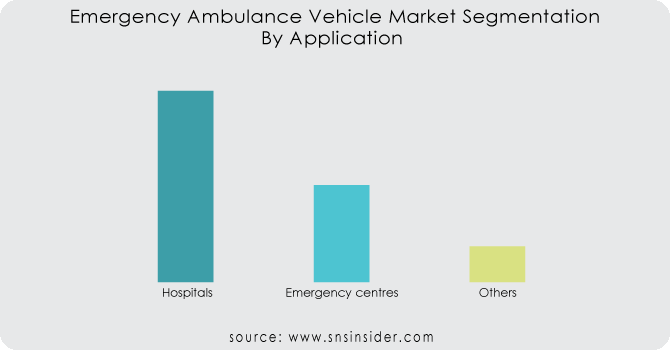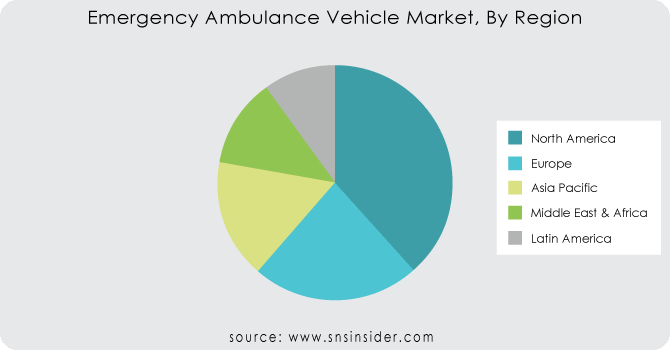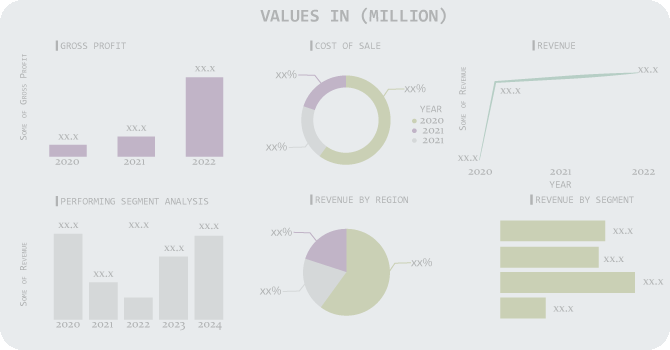Emergency Ambulance Vehicle Market Report Scope & Overview
The Emergency Ambulance Vehicle Market Size was valued at USD 15 billion in 2023 and is expected to reach USD 21.33 billion by 2031 and grow at a CAGR of 4.5% over the forecast period 2024-2031

Get More Information on Emergency Ambulance Vehicle Market - Request Sample Report
An ambulance is a crucial emergency vehicle outlined to transport sick or injured patients to hospitals. They too carry medical supplies for emergencies and give provide basic medical care to stabilize patients during transport. Ambulances come in different forms, including conventional ambulances, mobile ICU units, and nursing care vehicles. Prepared with essential medical equipment and medicine, they work as an expansion of a hospital in emergency situations. Staffed by paramedics and EMTs trained in giving pre-hospital care, ambulances play a basic part in saving lives during accidents, disasters and other crises.
MARKET DYNAMICS:
KEY DRIVERS:
- Rising acute diseases due to modern lifestyles and aging population fuel demand for emergency ambulance vehicles.
The rise of modern lifestyles characterized by screen time, inactivity, and unhealthy diets, is contributing to a surge in illnesses. This is especially concerning for the developing elderly population, who are more vulnerable to sudden heart issues. Due to the time-sensitive nature of acute conditions, quick transport to medical facilities is pivotal. Emergency ambulances, prepared to handle such critical situations, are therefore becoming progressively necessary. As the number of people experiencing intense sicknesses develops, so too will the demand for these life-saving vehicles.
- Ambulances are crucial for saving lives in rising traffic accidents.
RESTRAINTS:
- Advanced tech in ambulances improves care but raises costs, hindering market growth.
Advanced technology plays a vital role in modern ambulances but are high-priced. Equipping ambulances with the latest medical devices and equipment increases their overall cost. This is further compounded by the lengthy regulatory procedures and trials required before these technologies can be implemented. The high cost of these vehicles can potentially hinder the growth of the emergency ambulance market, especially in regions with limited budgets for healthcare.
OPPORTUNITIES:
- Rising acute diseases due to modern lifestyles create demand for emergency ambulance vehicles.
- Growing geriatric population with increased heart problems necessitates rapid ambulance response.
CHALLENGES:
- Rising costs of advanced medical technology impede affordability of emergency ambulances.
- Shortage of qualified paramedics and EMTs limits the effectiveness of emergency ambulance services.
IMPACT OF RUSSIA-UKRAINE WAR
The war in Russia-Ukraine has significantly impacted the Emergency Ambulance Vehicle Market. A critical surge in demand for ambulances in Ukraine estimated at 30% due to damaged or destroyed vehicles diverts resources towards the warzone, disrupting the global market. Sanctions and logistical challenges create supply chain disruptions, causing a potential global shortage of around 5-10% of ambulances. The war has also driven up production costs by an estimated 7-10% due to rising raw material and transportation prices, potentially straining budgets and limiting ambulance availability in some regions. Heightened risks in war zones discourage insurance companies from offering coverage, creating uncertainty for ambulance operators and hindering service availability. The war has shifted resources and production capacity towards military medical equipment, potentially delaying civilian ambulance deliveries by 2-4 months.
IMPACT OF ECONOMIC SLOWDOWN
Economic downturn can slowdown the Emergency Ambulance Vehicle Market. Government budgetary constraints may lead to a decrease in funding for emergency medical services (EMS) of around 5-7%, delaying ambulance fleet upgrades. Hospitals, facing economic strain, may delay investments in new equipment compatible with modern ambulances, potentially hampering patient care efficiency. The private ambulance service sector can also be impacted, with a potential decline of around 10% in non-emergency ambulance usage, impacting their revenue and ability to invest in new vehicles and technology. Developing economies, more susceptible to economic downturns, may see a decrease in ambulance purchases of around 8-12%, decreasing overall market growth. The limited lending restrictions can make it difficult for ambulance service providers to secure financing for new vehicles, potentially delaying fleet modernization.
KEY MARKET SEGMENTS:
By Product Type
- Vans
- Cards
- Motorcycles
- Other
Vans is the dominating sub-segment in the Emergency Ambulance Vehicle Market by product type holding around 60-70% of market share. Vans offer the most space for installing medical equipment and treating patients comfortably. Their larger size allows for better movability within the ambulance compared to cars. Additionally, the availability of various van configurations optimized for ambulance use makes them a versatile choice.
By Application
- Hospitals
- Emergency centres
- Others
Hospitals is the dominating sub-segment in the Emergency Ambulance Vehicle Market by application holding around 60-65% of market share. Hospitals handle a significant volume of emergency cases and require efficient ambulance services to transport patients for further treatment or specialized care. The well-established infrastructure and trained personnel at hospitals create a strong demand for ambulances to facilitate patient transfer.

Get Customized Report as per your Business Requirement - Request For Customized Report
REGIONAL ANALYSES
The North America is the dominating region in the Emergency Ambulance Vehicle Market, capturing an estimated 35-40% share. This dominance stems from its well-developed healthcare system with a focus on advanced emergency services, strict regulations ensuring proper equipment, and an aging population prone to chronic illnesses.
Europe is the second highest region in this market with a 25-30% share, boasting established healthcare systems that prioritize high-quality emergency care. A growing elderly population fuels the demand for advanced ambulances, while government initiatives and funding modernize ambulance fleets.
The Asia Pacific is experiencing the fastest-growth with 20-25% of share. This growth is driven by rapid economic development leading to investments in healthcare infrastructure and rising disposable income, allowing for greater access to emergency medical services

REGIONAL COVERAGE:
North America
-
US
-
Canada
-
Mexico
Europe
-
Eastern Europe
-
Poland
-
Romania
-
Hungary
-
Turkey
-
Rest of Eastern Europe
-
-
Western Europe
-
Germany
-
France
-
UK
-
Italy
-
Spain
-
Netherlands
-
Switzerland
-
Austria
-
Rest of Western Europe
-
Asia Pacific
-
China
-
India
-
Japan
-
South Korea
-
Vietnam
-
Singapore
-
Australia
-
Rest of Asia Pacific
Middle East & Africa
-
Middle East
-
UAE
-
Egypt
-
Saudi Arabia
-
Qatar
-
Rest of the Middle East
-
-
Africa
-
Nigeria
-
South Africa
-
Rest of Africa
-
Latin America
-
Brazil
-
Argentina
-
Colombia
-
Rest of Latin America
KEY PLAYERS
The major key players are EV Group (EVG) (India), Groupe Renault (France), Ford Motor Company (US), Life Line Emergency Vehicles (US), REV Group, MAN, Daimler AG, Life Line Emergency Vehicles, W.A.S. Ambulance, Leader Ambulance (US), B.A.U.S. AT (Poland), Tata Motors Limited (India), Toyota Motors Corporation (Japan), Sarvottam Appliances Private Limited (India) and other key players.
Groupe Renault (France)-Company Financial Analysis

RECENT DEVELOPMENT
-
In Aug. 2023: Huntsville Hospital merged with HEMSI ambulance service to improve healthcare access in North Alabama. This union aims for smoother emergency response and hospital care, ultimately benefiting the region's residents.
-
In May 2023: Empress EMS acquired Mobile Life to improve efficiency and service. This merger aims to streamline operations and minimize disruptions, ultimately benefiting patients in both companies' service areas.
| Report Attributes | Details |
|---|---|
| Market Size in 2023 | US$ 15 Billion |
| Market Size by 2031 | US$ 21.33 Billion |
| CAGR | CAGR of 4.5% From 2024 to 2031 |
| Base Year | 2023 |
| Forecast Period | 2023-2031 |
| Historical Data | 2020-2022 |
| Report Scope & Coverage | Market Size, Segments Analysis, Competitive Landscape, Regional Analysis, DROC & SWOT Analysis, Forecast Outlook |
| Key Segments | • by Type (Vans, Cars, Motorcycles, Others) • by Application (Hospitals, Emergency Centers, Others) |
| Regional Analysis/Coverage | North America (US, Canada, Mexico), Europe (Eastern Europe [Poland, Romania, Hungary, Turkey, Rest of Eastern Europe] Western Europe] Germany, France, UK, Italy, Spain, Netherlands, Switzerland, Austria, Rest of Western Europe]), Asia Pacific (China, India, Japan, South Korea, Vietnam, Singapore, Australia, Rest of Asia Pacific), Middle East & Africa (Middle East [UAE, Egypt, Saudi Arabia, Qatar, Rest of Middle East], Africa [Nigeria, South Africa, Rest of Africa], Latin America (Brazil, Argentina, Colombia Rest of Latin America |
| Company Profiles | EV Group (EVG) (India), Groupe Renault (France), Ford Motor Company (US), Life Line Emergency Vehicles (US), REV Group, MAN, Daimler AG, Life Line Emergency Vehicles, W.A.S. Ambulance, Leader Ambulance (US), B.A.U.S. AT (Poland), Tata Motors Limited (India), Toyota Motors Corporation (Japan), and Sarvottam Appliances Private Limited (India) |
| Key Drivers | •Increase in road traffic accidents around the world. •The emergence of new ailments is boosting the market's expansion. |
| RESTRAINTS | •Increasing automobile prices will be a hindrance to future growth. •Lack of awareness about spending power and uptake of ambulance services. |

